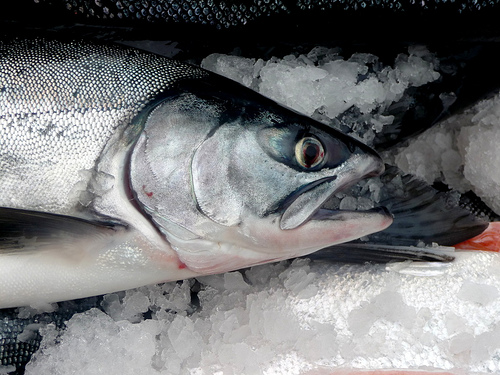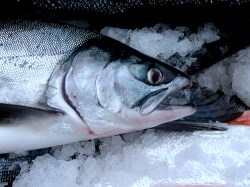AquaBounty Technology’s genetically modified salmon just got a hefty financial boost from the USDA: On Monday, the agency awarded the Massachusetts-based company $494,000 to study technologies that would render the genetically tweaked fish sterile. This would reduce the likelihood they could reproduce with wild salmon, should any escape into the wild — a scenario that has many environmentalists concerned.
The Atlantic salmon, which is branded with the name AquAdvantage, has been genetically altered with a growth-hormone gene from a Chinook salmon and a “genetic on-switch” gene from an ocean pout that will allow the fish to grow all year round, reaching market size much faster than traditional salmon.
In mid-2010, AquaBounty’s salmon appeared to be on the fast-track for approval by the FDA, which would have made it the first genetically modified animal approved for human consumption. But the process has since been stalled. Lawmakers in states like California and Alaska have been actively introducing legislation that requires the fish to be labeled as a GMO product or to prohibit its production entirely. Then, this June, the House of Representatives voted to prohibit the FDA from using funds for approval of the salmon.
The same bill the House voted on (an Agriculture Appropriations amendment) is currently stalled in the Senate. Now the USDA grant is raising eyebrows. Upon FDA approval, the company would sell salmon eggs to aquaculture operations looking to farm the fish.
AquaBounty points out that FDA approval requires that eggs only be sold to contained inland facilities that are approved and subject to subsequent inspection by the agency, and says there is no danger of escape. But industry watchers, like Ocean Conservancy’s aquaculture program director George Leonard are concerned nonetheless.
“They have done no quantitative risk and failure analysis,” says Leonard. “It is true that net pens aren’t in the immediate future, but clearly there will be pressure to farm them there. There is an entire industry infrastructure that could accommodate these fish. If eggs are sold to other countries, which must certainly be part of the business plan, there is no guarantee that they will follow the same guidelines as the FDA.”
In fact, the fish are already being shipped to Panama and Canada’s Prince Edward Island for grow out.
The majority of farmed salmon are raised in open-net ocean pens, a practice environmentalists have condemned for years because of escapement, pollution, and disease. So it’s no surprise that the issue of reproductive ability is being closely scrutinized.
The FDA released a Veterinary Medicine Advisory Committee report in September 2010 saying, “we have reason to believe that the population of triploid, all-female AquAdvantage Salmon will be effectively sterile,” and AquaBounty’s own website promotes the sterility of the fish. In an email to Grist, however, Ronald L. Stotish, CEO and president of AquaBounty acknowledged that their technology is not yet 100-percent effective — thus the need for the FDA funding.
Stotish says AquAdvantage Salmon are currently rendered sterile by a “pressure treatment process that has been validated to 99.8-percent effectiveness.” The fish are also all female, and will be raised in physical containment. “Because the company realizes that our detractors do not respond to reason and science,” added Stotish, “we are developing a genetics-based process that will allow us to breed 100 percent sterile offspring. That is 100 percent sterile, guaranteed.”
That certainly sounds responsible, but GMO salmon fact sheet released in June by the advocacy group Food and Water Watch suggests that the numbers may not be so airtight. According to their research, which cites an environmental assessment from the FDA briefing packet on AquAdvantage salmon, “up to 5 percent of these fish may be fertile.”
But even Stotish’s .2 percent number worries Leonard, as a handful of escaped fish every year could make a big difference over time. “If AquaBounty hasn’t yet figured out how to make the salmon fully sterile, then they shouldn’t be applying to the FDA to deploy the fish,” he says. “Let’s fix the problem first, not after the salmon get out.”
Colin O’Neil, regulatory policy analyst for the Center for Food Safety, an environmental advocacy group focused on genetic engineering, says this is the first time they’ve heard of the USDA being involved with the genetically engineered fish.
“If the FDA was so assured of the scientific merits of this application, they would have approved it by now,” he says. “The mere fact that it has taken this long tells me that the jury is still out.”
The grant comes on the heels of the company’s interim report released on Friday, which announced a net loss of $2.8 million, and a reduction of three board members. In other words, it’s clear that AquaBounty is under the gun to roll out their business and begin “literally own[ing] salmon farming,” as Paul Greenburg put it in a recent article.
Stotish says the delays in approval are because of groups who have “intimidated regulators with threats of lawsuits” and “misled the public ” He adds that the company remains optimistic that congress will will not shrink from what he calls “their commitment to science-based regulation,” and that it will “stand up to the pressure from the anti-technology groups.”
According to O’Neil, however, a great deal of the scientific community is actually weighing in on the side of caution. “It would be reckless for the FDA to approve genetically engineered salmon given the large number of environmental, human health, animal welfare and economic risks that have been raised by scientists, members of Congress and members of the FDA’s own Advisory Committee,” he says.
Note: This story was edited on Sept. 30 to more accurately reflect the proposed FDA regulations on containment of the salmon.




